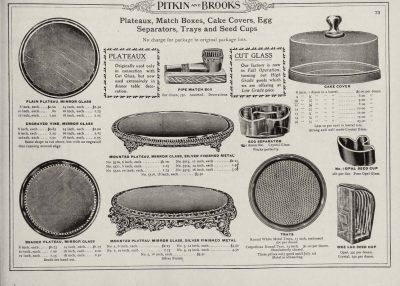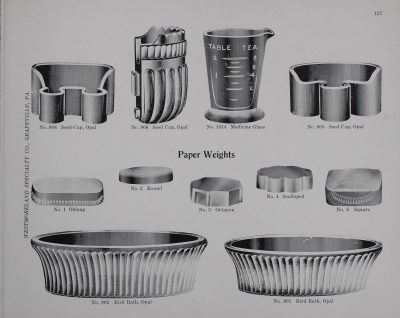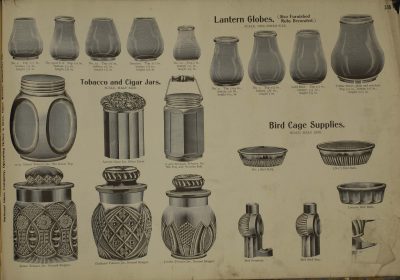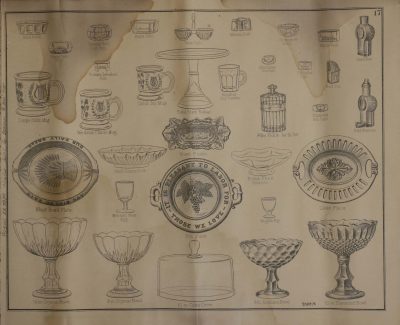
Catalog page from a London firm which
sold a variety of goods, including crystal
bird fountains, seed boxes, and bird baths.
Silber & Fleming (about 1885-1889).
Rakow Library collection. CMGL 89888.
Full catalog online.
This time of year, bird lovers are still enjoying the sight of tiny, brilliantly-colored birds racing by their windows in a blur of beating wings. Have you ever thought about the original feeders developed for these minuscule flyers? Unlike bird feeders made to hold seed and thistle, hummingbird feeders require some special features: they need to securely hold liquids, yet allow for a hummer to feed easily using its tongue, be sturdy enough to hold up to outdoor conditions, and be easily cleaned since the nectar needed to feed hummingbirds easily spoils in the hot weather. Small glass bottles and tubes were an early choice for do-it-yourself hummingbird researchers in the early 1900s. These little glass bottles would be taped at an angle to tree branches and flowering bushes so that the nectar stayed in the bottle but the small opening was accessible for the hummingbird to feed from.
Having too large of an opening could be a problem, as one hummingbird enthusiast discovered when she tried doubling the capacity of her popular feeders by increasing the bottle size, only to have one of the small birds fall in the nectar and remain overnight, unable to back out of the bottle. He was rescued in the morning, never fear! And the larger bottles were retired immediately.
There were several early hummingbird feeders and glass was often an important element in their construction. One of these, the “Webster Feeder,” as it was known, was designed by Laurence J. Webster for his wife, the passionate bird enthusiast who rescued our poor hero above.
- 1899 Pitkin & Brooks catalog illustrating crystal and opal seed cups. Rakow Library collection. CMGL 52895. Full catalog online (http://exhibitdb.cmog.org/opacimages/PDFs/Books/Rakow_1000112569.pdf)
- 1924 Westmoreland Specialty Company catalog depicting seed cups and bird baths in opal glass. Rakow Library collection. CMGL 55023 Full catalog online. (http://exhibitdb.cmog.org/opacimages/PDFs/Books/Rakow_2000015481.pdf)

1868 catalog page from McKee & Brothers showing a bird bath in crystal. Rakow Library collection. CMGL 28856. Full catalog online.
Mrs. Webster’s feeders helped popularize a growing interest for bird lovers across the country. Mrs. Webster had been feeding her hummingbirds for many years using small bottles, which she cleaned and refilled daily. But she was in the special circumstance of having a husband who was an M.I.T. engineer. As a gift for his wife, Laurence Webster designed a blown glass feeder with two openings for food and a handy hook at the top for hanging the feeder. Then he asked the glass-blowing department at his alma mater to create a prototype in bright red. It was this version that was eventually marketed to the public for $3.00 as the Webster Hanging Feeder. It wasn’t available long, as it soon sold out of its limited quantities.
Since then, glass hummingbird feeders are popular items. You can even find the classic Webster Feeder available once again, as well as feeders shaped like flowers, bulbs, orbs, ornaments, and so on.
Of course, we’ve been making concoctions for birds from glass for centuries. In our trade catalog collection, you will see fancy glass fountains and bird baths fit for palaces; bird houses and cages made of glass and wire; and feeders for other types of birds, which dispense seeds in little trays and cups and tubes. You could argue, in fact, that glass is for the birds … or the bird enthusiasts!
- Bird cage supplies from a McKee & Brothers catalog, late 19th century-early 20th century. Rakow Library collection. CMGL 110922. Full catalog online. (http://exhibitdb.cmog.org/opacimages/PDFs/Books/Rakow_1000080507.pdf)
- 1882 McKee & Brothers catalog illustrating bird cups, bird fountains, and seed boxes. Rakow Library collection. CMGL 73573. Full catalog online. (http://exhibitdb.cmog.org/opacimages/PDFs/Books/Rakow_1000096509.pdf)
The Rakow Research Library is open to the public 9am to 5pm every day. We encourage everyone to explore our collections in person or online. If you have questions or need help with your research, please use our Ask a Glass Question service.





2 comments » Write a comment